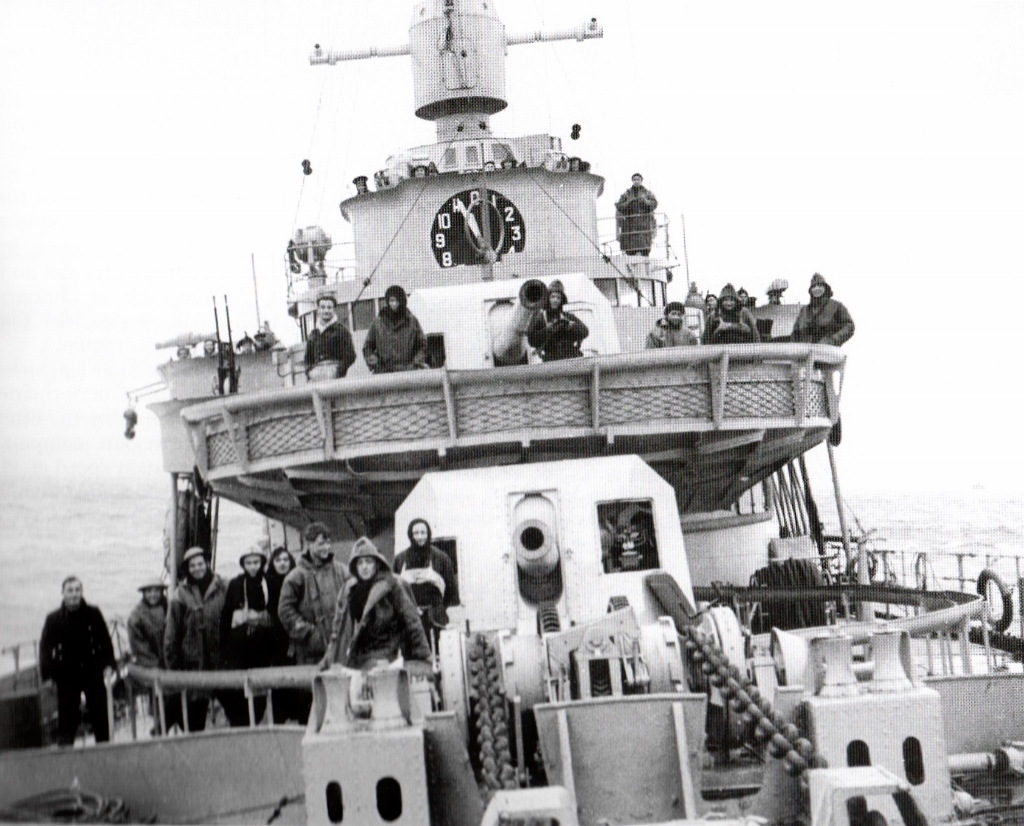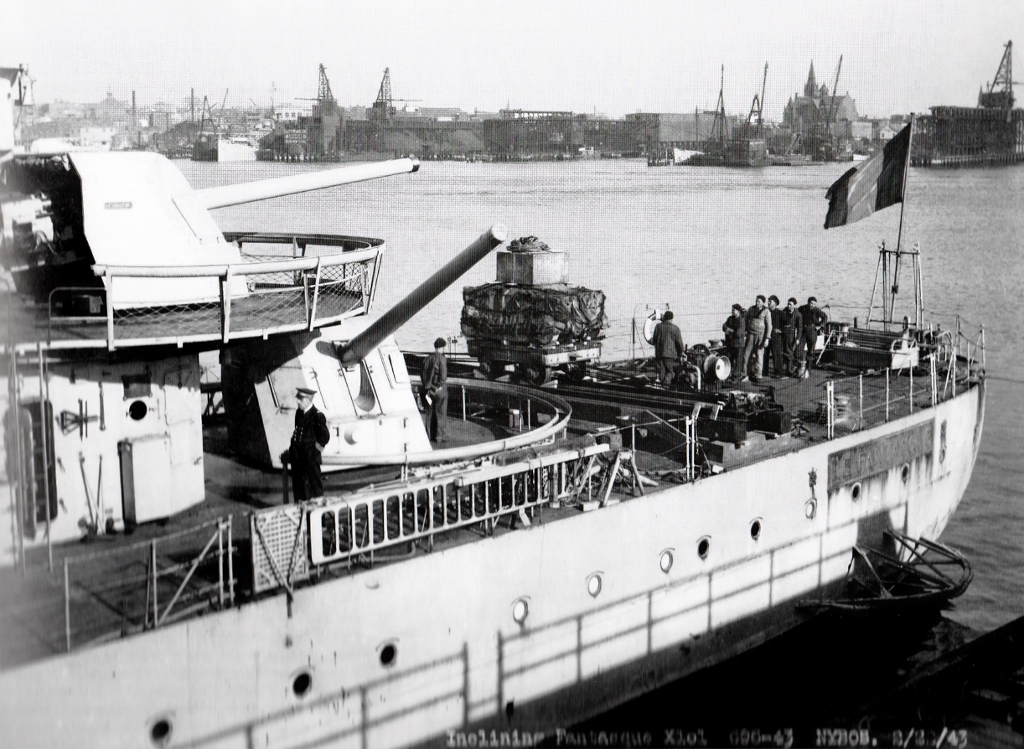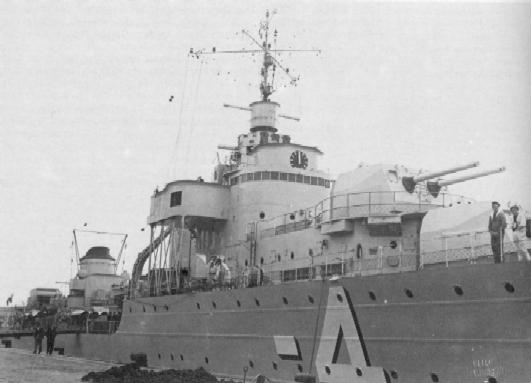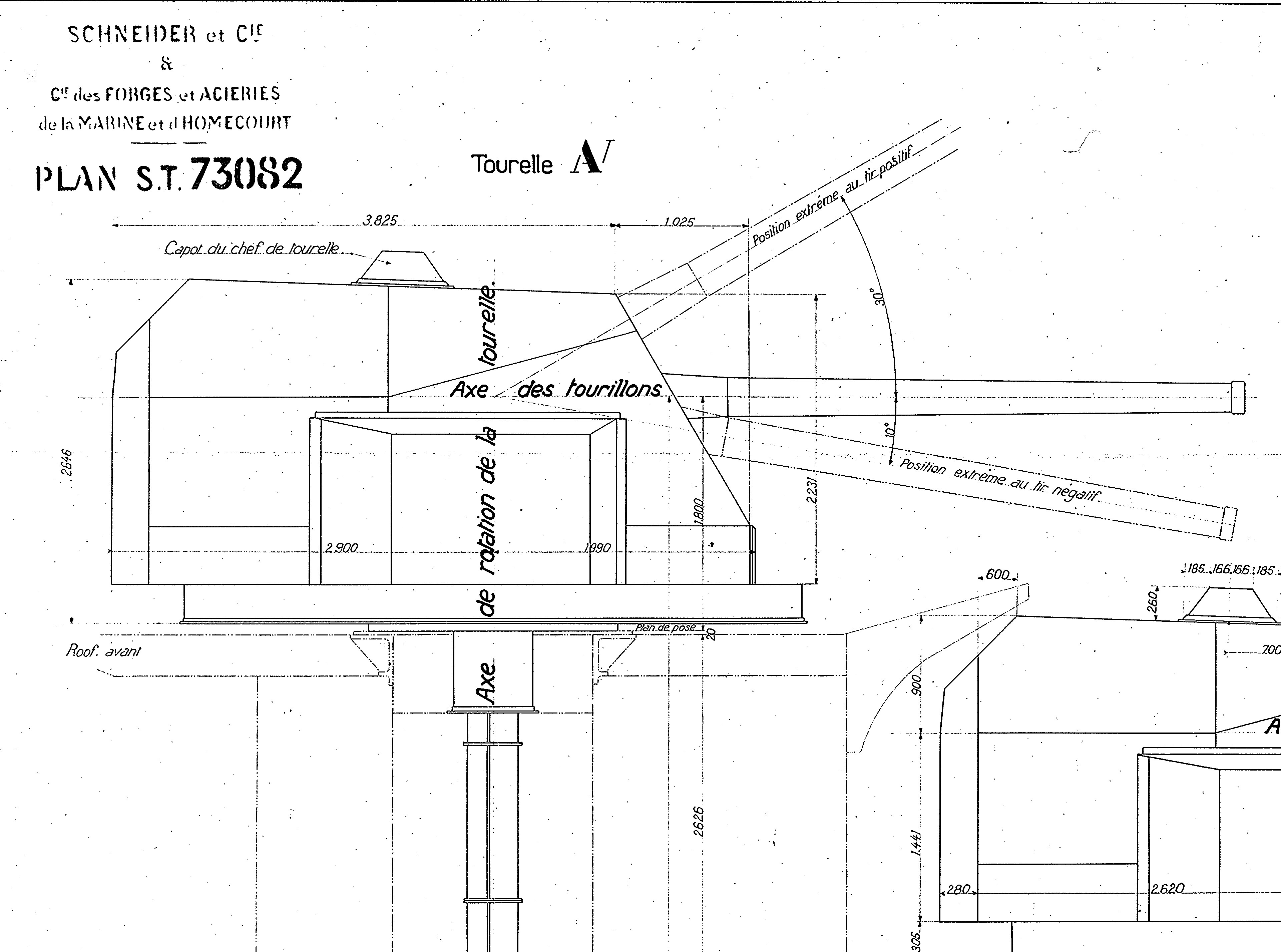
The success of the 138.6 mm/40 (5.46") Model 1927 led to the development of these more powerful weapons. For the first time, power elevation and training were provided to destroyer gun mounts, which arguably made them France's best destroyer guns of World War II. Unfortunately, the lack of a high elevation capability made them useless against aircraft. They were also fragile and complicated weapons, conditions which made it difficult for them to achieve their official rate of fire. RPC was fitted to the Le Fantasque class, but this was not a success and the equipment was gradually removed during their service lives. The ammunition hoists were to a new design based upon those used for the 152 mm guns on the light cruisers but were prone to jamming. Some of these faults were corrected just before and just after the start of the war but the French surrender in 1940 greatly slowed progress and the scuttling of many of these ships in 1942 ended further work.
The main difference between Model 1929 and Model 1934 was in the design of the breech mechanism and in the mounting arrangements. The Model 1929 was designed for single mountings while the Model 1934 was designed for twin mountings. The twin mounting had an extensive shield which offered obvious operational advantages over the half-shield mountings used on all previous French destroyers.
Built with a monobloc autofretted barrel and a breech ring that was screwed on cold. The breech mechanism was a sliding block of semi-automatic operation.
| Designation | 138.6 mm/50 (5.46") Model 1929
138.6 mm/50 (5.46") Model 1934 and Model 1934 R1938 1 |
|---|---|
| Ship Class Used On | Model 1929: Le Fantasque (2,610 tonnes) class
Model 1934 and 1934 R1938: Volta (2,930 tonnes) class. Planned for the Kléber and Bruix classes |
| Date Of Design | 1929 / 1934 |
| Date In Service | 1935 / 1939 |
| Gun Weight | Model 1929: 4.21 tons (4.28 mt)
Model 1934: 4.58 tons (4.65 mt) |
| Gun Length oa | 286.6 in (7.280 m) |
| Bore Length | 272.7 in (6.927 m) |
| Rifling Length | 229.7 in (5.836 m) |
| Grooves | (42) 0.048 in deep x 0.289 (?) (1.22 mm x 7.35 mm (?)) |
| Lands | 0.118 (3 mm) (?) |
| Twist | Uniform RH 1 in 22.35 |
| Chamber Volume | 1,242 in3 (20.36 dm3) |
| Rate Of Fire | Model 1929: 12 rounds per minute maximum, 7 rounds per minute practical
Model 1934: 5 to 9 rounds per minute 2 |
- ^Numerous modifications and adjustments of the Model 1934 were made after the failure of the initial firing trials, including changes to the breech mechanisms, catapult rammers and the loading trays. Following these changes, the guns were re-designated as "mle 1934 R1938" where "R" stood for révisé - revised.
- ^The Model 1934 was similar to the Model 1929 but had a different breech mechanism which was found to be seriously defective. Poor design led to projectiles often being out of alignment with the breech during ramming. This plus poor workmanship led to frequent jams which had to be manually removed. Early trials for this model showed a rate of fire of 3 to 4 rounds per minute with frequent jams and failures. See mounting notes below for further information.
| Type | Separate |
|---|---|
| Projectile Types and Weights 1a 2a 3a | SAP M1924: 88.0 lbs. (39.9 kg)
HE M1928: 89.5 lbs. (40.6 kg) HE M1932: 88.6 lbs. (40.2 kg) Starshell M1925: 66.1 lbs. (30.0 kg) |
| Bursting Charge | SAP: 5.3 lbs. (2.4 kg)
HE: 9.0 lbs. (4.1 kg) |
| Projectile Length | SAP: 26.9 in (68.3 cm)
HE: 27.3 in (69.3 cm) |
| Propellant Charge | 26.65 lbs. (12.09 kg) BM11
Cartridge weight filled: 52.07 lbs. (23.62 kg) |
| Cartridge Case Type, Size and Empty Weight 4a | Brass, 130 x 900 mm, 28.57 lbs. (12.96 kg)
Cartridge lip was 7.38 in (18.75 cm) |
| Muzzle Velocity | SAP: 2,625 fps (800 mps)
HE: 2,756 fps (840 mps) |
| Working Pressure | 15.9 tons/in2 (2,500 kg/cm2) |
| Approximate Barrel Life | N/A |
| Ammunition stowage per gun | Le Fantasque: 100 rounds 5a Volta: 108 rounds 6a |
- ^Projectile Designations
SAP M1924 OPFA Mle 1924 HE M1928 OEA Mle 1928 HE M1932 OEA Mle 1932 Starshell OEcl M1925 HE M1928 was carried by the Le Fantasque class while the Volta class carried the HE M1932.
- ^The French designation for the SAP shell is the same as used for AP but the SAP projectile lacked an AP cap.
- ^In the spring of 1940 dye-filled OPFK (SAP) shells were issued. It was customary that the first ship in a division used green dye, the second white - later yellow - and the third red.
- ^The same size cartridge case was used in all 138.6 mm (5.46") guns from the Model 1910 onwards, although the type and quantity of propellant was not always the same.
- ^As completed the outfit for the Le Fantasque class was 500 rounds of HE and SAP plus 75 starshell. 525 charges were carried of which 25% were flashless. There were also 80 charges for the starshells. When the war started, the magazines were altered to hold 200 rounds per gun and ready racks were installed at each gun which held 24 rounds. Given the unreliability of the hoists, the racks were frequently overloaded when combat was imminent.
- ^Peacetime outfit of the Volta class was 650 rounds of HE and SAP plus 75 starshells. Wartime outfit was increased to 1,440 rounds of HE and SAP plus 85 starshells. There was room to store 1,590 cartridge cases and starshell was stored in a separate ammunition room which fed turret number 2. Following initial trials, ready-use racks holding five complete rounds were worked into each turret in order to compensate for the frequent breakdowns in the ammunition supply systems.
| Elevation | Distance |
|---|---|
| 30 degrees | 21,872 yards (20,000 m) |
| Designation | Single Open Mounts 1b 2b Le Fantasque (5): Model 1929 Two-gun Enclosed Mounts 3b 4b 5b 6b |
|---|---|
| Weight | Model 1929: 11.39 tons (11.57 mt)
Model 1935: 34.05 tons (34.6 mt) |
| Elevation 7b | Model 1929 and 1934: -10 / +30 degrees
Model 1935: -10 / +30 degrees 8b |
| Elevation Rate | Model 1929: Manually operated, only
Model 1935: 14 degrees per second |
| Train | Model 1929: about +150 / -150 degrees
Model 1935
|
| Train Rate | Model 1929: Manually operated, only
Model 1935: 10 degrees per second |
| Gun recoil | 20 in (50 cm) |
| Loading Angle | Any 3b |
- ^Single mounts were manually trained and elevated. There were four shell and four cartridge hoists in the fixed structure, with guns Numbers 3 and 4 sharing one set. Shell hoists were electrically powered pusher types made to a new design with the projectiles carried vertically. Cartridges were loaded vertically into a rotating drum which fed the cartridge hoists. Both projectiles and cartridges were off-loaded onto horizontal delivery trays at one of two reception points. The change in orientation at the reception points created a serious potential for jams and occasionally shells would fall back down the delivery tubes. Ammunition slides ran from the hoists to the guns. Shells were delivered via circular chutes as in earlier 138.6 mm guns while cartridges were delivered via linear chutes to the rear of the mountings. The ammunition hoists on Le Fantasque were modified during a 1940 refit at Lorient to remove the intermediate reception station. Following the refit, she fired 250 rounds without a single jam during trials off Dakar in September 1940.
- ^No. 4 gun was removed from Le Triomphant during a 1940 refit in Britain and a 4"/45 (10.2 cm) for AA use was fitted in its place. British light AA guns were also fitted in place of the original French AA guns at this time.
- ^3.13.2
The twin mounts were open-back pseudo-turrets which lacked a stalk and with a canvas screen at the rear which was later replaced by a roll-down metal shutter. Each mounting had two shell and two projectile pusher hoists which came up between the guns. The hoists did not rotate with the mounting and instead fed a rotating tipping drum called a barillet de reception. When a full set of two projectiles and two cartridges arrived at the drum they compressed a set of springs and the drum then rotated to conform with the training angle of the mounting. When aligned with the guns the drum tipped over horizontally and the springs pushed the projectiles and cartridges out onto loading trays. The loading trays pivoted 180 degrees and the catapult rammer pushed the projectile into the breech. Cartridges were loaded manually. Gun crews for each two-gun turret were eight crewmen - a commander, trainer, layer, platform adjustment operator, tipping drum operator, two gun loaders and an empty cartridge handler. As only two crewmen were loaders and maintaining a high rate of fire was physically intensive, this led to a diminishing rate of fire during prolonged firing periods. As can be seen by this description, the ammunition handling system was a complicated design and the mechanism was prone to defects and jams. As a result, the intended rate of fire was not achieved. In addition, John Jordan in "The Contre-Torpilleurs of the Mogador Class" says that the catapult rammers were so under-powered that loading was impossible at any angle above +10 degrees. Following the changes mentioned above for the R1938 modifications, Mogador achieved nine successful reloads out of ten with the guns at a modest elevation during firing trials in July 1938. These changes were considered to be a short-term fix and more changes were planned including separate loading trays for the projectiles and cartridges. These changes were incorporated into Volta as built but Mogador was unchanged prior to her scuttling. Rammers were later strengthened on Mogador but Volta retained the weak ones. During trials, Volta was able to achieve a ROF of nine rounds per minute for a short time but the average was 5 to 6 rounds per minute.
- ^The elevation and training motors were originally inside the twin mountings, but were moved to external "pods" in order to free up space for ready ammunition racks.
- ^RPC was planned for the twin mountings but abandoned following the failure of this equipment on the Le Fantasque class.
- ^The distance between the gun axes was 52.4 in (133 cm).
- ^The planned ships of the Kléber class would have had a maximum elevation of +35 degrees, but these ships were canceled upon France's defeat in 1940.



"Naval Weapons of World War Two" by John Campbell
"The Last Super Destroyers?: Mogador and Kléber Classes" article by Robert Dumas in "Warship Volume VIII"
"The Contre-Torpilleurs of the Mogador Class" by John Jordan article in "Warship 2007"
"French Destroyers: Torpilleurs d'Escadre & Contre-Torpilleurs 1922 - 1956" by John Jordan and Jean Moulin
"Navies of the Second World War - The French Navy" by Henri le Masson
"The French Fantasque Class, 1930" article by Jacques Mordal in "Warship Special 2: Super Destroyers" edited by Antony Preston
"Destroyers of World War Two" by M.J. Whitley
---
Email correspondence with John Jordan on 21 October 2019
14 October 2007 - Benchmark
31 March 2010 - Corrected typographical error
28 March 2012 - Updated to latest template
25 September 2015 - Added photograph of Le Fantasque, additional information on guns, ammunition and mountings
22 November 2017 - Corrected max elevation of the Model 1935
22 October 2019 - Converted to HTML 5 format, added mounting sketch
12 February 2022 - Corrected typographical error
